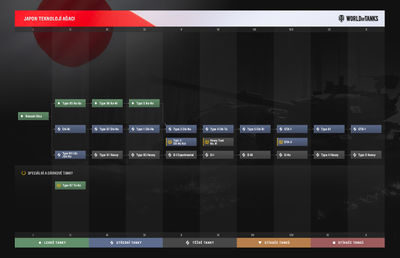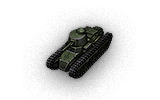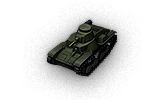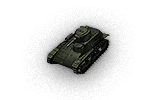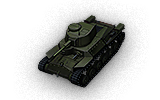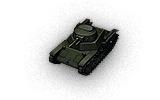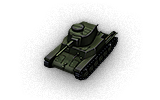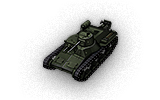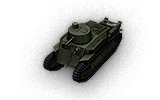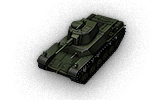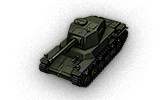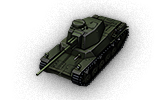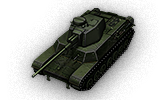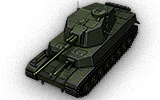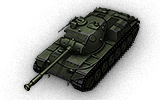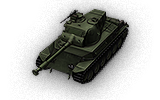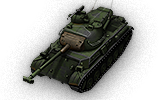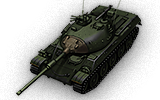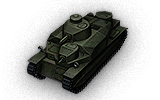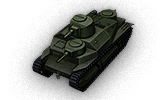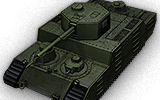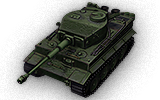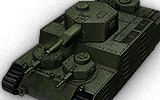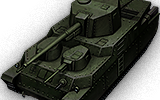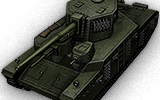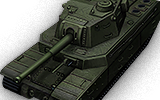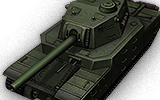Difference between revisions of "Tanks of Japan"
| Revision as of 08:45, 2 December 2015 Haswell:na moved page Japan to Tank nation japan | Revision as of 11:12, 19 November 2019 | |||
33 intermediate revisions by 16 users not shown | ||||
| Line 1: | Line 1: | |||
| ? | [[image:Graffiti_stickers_japan.png|left|link=|]] Tanks designed and produced by Imperial | + | {{DISPLAYTITLE:Japan}} | |
| + | [[image:Graffiti_stickers_japan.png|left|link=|]] Tanks designed and produced by Imperial Japanese Army and the Japanese Self-Defense Forces. | |||
| ---- | ---- | |||
| ? | + | Japanese Tank was introduced in World of Tanks update version 8.10. Currently, there is one end-tier medium tank line (two branches until tier 5 with mediums and light tanks) and heavy tank line. A tank-destroyer branch has been mentioned by WG, which is possibly going to be released in 2020. | ||
| ---- | ---- | |||
| ? | [[image:Tank Tree Japan.jpg|thumb|right|400px|0.9. | + | [[image:Tank Tree Japan 0.9.18.jpg|thumb|right|400px|0.9.18 Japanese Tank Tree]] | |
| ? | Althrough Japanese heavy tanks greatly differs from Japanese medium and light tanks, they all share few similarities | + | Althrough Japanese heavy tanks greatly differs from Japanese medium and light tanks, they all share few similarities; All Japanese tanks have great gun depression, (with exception being Chi-Nu Kai and some heavy tanks that have limited depression above their miniturrets), lack of sloping on armor (except on tier 8 - 10 medium tanks), and good firepower. | |
| ? | Japanese medium and light tanks have few more things in common. They all have poor armor thicknesses, however, higher tier mediums (most notably the STB-1) have sloped armor, which may result in lucky bounces. They also combine good gun depression with guns that have excellent penetration and a good balance between alpha and ROF. In the first few tiers, the Japanese tanks can seem to prove to be a real turn off. Guns have generally | + | Japanese medium and light tanks have few more things in common. They all have poor armor thicknesses, however, higher tier mediums (most notably the STB-1) have sloped armor, which may result in lucky bounces. They also combine good gun depression with guns that have excellent penetration and a good balance between alpha and ROF. In the first few tiers, the Japanese tanks can seem to prove to be a real turn off. Guns have generally average accuracy and handling. Most Japanese medium and light tanks have decent camo values for their class. | |
| ? | At tier II, the line splits between [[Medium Tanks|medium tanks]] and [[Light Tanks|light tanks]]. Japanese light tanks offer good speed and agility, culminating into the Type 5 Ke-Ho, which is small, fast, agile, and packs a surprising punch. However, to balance these overall good characteristics, the three light tanks in the Japanese line lack in armor even more so than their medium counterparts, and are not exactly specialized for scouting in general. | + | At tier II, the line splits between [[Medium Tanks|medium tanks]] and [[Light Tanks|light tanks]]. Japanese light tanks offer good speed and agility, culminating into the Type 5 Ke-Ho, which is small, fast, agile, and packs a surprising punch. However, to balance these overall good characteristics, the three light tanks in the Japanese line lack in armor even more so than their medium counterparts, and are not exactly specialized for active scouting in general. | |
| In the diverging medium tank line, agility is traded for additional firepower and flexibility, a shining example being the Type 97 Chi-Ha, which while albeit cumbersome, possesses great firepower and accuracy for its tier, which enables it to play not only as a support medium but also a tank destroyer. The Medium tanks, along with their light tank cousins, are somewhat lacking in armor overall compared to their international peers. | In the diverging medium tank line, agility is traded for additional firepower and flexibility, a shining example being the Type 97 Chi-Ha, which while albeit cumbersome, possesses great firepower and accuracy for its tier, which enables it to play not only as a support medium but also a tank destroyer. The Medium tanks, along with their light tank cousins, are somewhat lacking in armor overall compared to their international peers. | |||
| ? | At tier V, the medium and light tanks lines reunite, and the Japanese tank line focuses solely on mediums which have decent | + | At tier V, the medium and light tanks lines reunite, and the Japanese tank line focuses solely on mediums which have decent damage output as the line reaches later tanks, all of which have the capability to switch roles seamlessly when required. Past tier V, the medium tanks take rather wild variations between tiers. The tier 6 Chi-to is known for its overall good maneuverability for its size. The tier 7 Chi-Ri is notable for its very large size, rivaling the bulkiness of the German tanks found in the E50M line, being even bigger than some heavies of its tier, which makes it an enticing artillery target. Yet to trade for its large size, the Chi-Ri has the ability to equip a dangerous autoloader. In addition, to compensate for these wild variations, all of the late-tier Japanese tanks feature above-average to good health pools, some rivaling those found along the E50M line as well. | |
| ? | In the last few tiers, the turrets of the Japanese tanks, while not greatly increasing in armor thickness, begin to become well-rounded and sloped like their Chinese counterparts | + | In the last few tiers, the turrets of the Japanese tanks, while not greatly increasing in armor thickness, begin to become well-rounded and sloped like their Chinese counterparts. The top of the tree; the STB-1 for instance has among the shallowest sloped turrets in the game, able to bounce nearly any shot, as well as having a special hydropneumatic suspension shared with [[Sweden|Swedish]] high tier medium tanks, which allowed a room for more terrain usage for extra protection. They also likewise have cramped modules and crew. However, in contrast they still retain their excellent gun depression but also abysmal hull armor. | |
| + | ||||
| + | In essence, they are not jack-of-all trades and masters of none like the Russian Mediums, but are extremely potent as second line support tanks, and if handled properly can even take on primary roles in a pinch, if only temporarily. | |||
| Overall those who expect to see Japanese medium tanks brawl effectively will be generally disappointed and surprised, as all of the tanks in the Japanese medium line lack strong armor found in Russian and German tanks that will be sufficient for such. However, those who prefer a supporting role, sniping, flanking, etc. will very much enjoy what the Japanese mediums have to offer. | Overall those who expect to see Japanese medium tanks brawl effectively will be generally disappointed and surprised, as all of the tanks in the Japanese medium line lack strong armor found in Russian and German tanks that will be sufficient for such. However, those who prefer a supporting role, sniping, flanking, etc. will very much enjoy what the Japanese mediums have to offer. | |||
| ? | Other than few similarities mentioned earlier, Japanese heavy tanks are nearly polar opposities of medium tanks. They generally have terrible mobility | + | Other than few similarities mentioned earlier, Japanese heavy tanks are nearly polar opposities of medium tanks. They generally have terrible mobility , flat but extremely thick armor (After tier 5), good gun depression, huge HP pools and large, inaccurate guns. Japanese heavy tanks lacks real weakspots on front, but at cost they are much worse at angling than their [[Germany|German]] counterparts due to either terrible side armor or having weak cheeks on front that becomes easily penetratable when angled. They are also the biggest tanks in the game, being notably bigger than even the Maus, making them very easy targets from artillery. They're also known for great module compatibility and don't require new turret or suspension to improve performance, making the Japanese heavy line fairly easier to grind than others tech line in the game. | |
| + | ||||
| + | The Low tier Japanese heavy tanks, The Type 91 and Type 95 have a design that resemblance with French interwar tanks (such as the B1). Unfortunately, these tanks suffers from poor mobility and armor. They do have excellent damage per minute, gun depression and choice for a guns with decent HE shells that can be crippling against most tanks in the same tier, though. | |||
| + | ||||
| + | The tier 5, O-I Experimental, is the transit between starting tiers and higher tiers. It has drastically changed from its predecessor by turning into giant, heavily-armored tank that offers excellent protection for its tier. However, its size can be troublesome because you'll easily get hit by enemies (especially SPGs). In addition, unlike the higher tier Japanese heavy tanks, the O-I Experimental has several issues - it suffers from poor roof armor, frontal weakspots and lower caliber guns. However, also unlike the higher tier Japanese heavy tanks, the O-I Experimental has relatively decent rate of fire with it's both guns, as well as moderately good accuracy and gun handling (with the 7.5 cm gun). | |||
| + | ||||
| + | From tier 6 and above, Japanese heavy tanks are generally quite similar: they have option of two guns - 15 cm howitzers that primarly fire HE shells, or mid to large caliber gun that primarly fires AP shells, with mediocre to good penetration and decent to high alpha damage, but poor accuracy and DPM. They have very tough frontal armor with few weakspots, are gigantic, have poor mobility, generally poor side armor (that however gradually increases at higher tiers) and very high health pool. | |||
| + | ||||
| + | The infamous O-I is capable of oneshotting most same tier tanks and is unique due to having sturdy rear armor thicker than a few peers' upper glacis, but it has extremely long reload on its 15 cm gun. O-Ni carries similar guns but has notably improved soft stats, acceleration and frontal armor, but most importantly, it gets a massive health boost. It also gets a new 10 cm gun with slightly higher alpha damage and penetration, but even worse rate of fire. The 15 cm howitzers are the most effective choices at these tiers, as they are still able to deal devastating damage, and even without penetration, the HE shells are able to severely cripple the enemy tanks. | |||
| ? | + | At higher tiers, the howitzers become less attractive, while their side armor gets gradually better. The O-Ho has better gun handling with its 15 cm gun than the O-Ni, but is otherwise a rather marginal upgrade, and the tank also suffers severely from the frontal gun depression issues. It does get significantly higher rate of fire with 10 cm gun, though, but it also doesn't gain extra alpha damage and it's accuracy and gun handling are still very poor. At tier 9-10 position, the Types receive completely new gun choices with the AP guns having notably higher alpha damage. The Type 4 Heavy loses miniturrets from its predecessor and gains much stronger side protection, making angling a more viable option, but suffers from even worse mobility and hull cheeks that limits angling ability. It does get a powerful 14 cm gun with highest alpha damage of all the heavies in it's tier with reasonably good penetration with it's standard rounds. The apex of Japanese heavies, Type 5 Heavy, has much tougher side armor and hull cheeks no longer being outright weakspots, meaning that it can finally sidescrape effectively, something that earlier Japanese heavies could not. It also has fairly good gun handling and very high health pool for it's tier, though it's damage per minute is poor and it's penetration isn't as attractive as it was on the Type 4 Heavy. The Type 4/5 are still able to use 15.2 cm HE guns, but their damage output is very poor for their tiers (not improved from mid-tiers at all aside from their super expensive HESH shells that can only penetrate lightly to moderately armored targets), so using these guns is not recommended under most circumstances. | ||
| ? | + | {{VideoYT|bGgm7HiQDLM|320}} | ||
| {{separator|small}} | {{separator|small}} | |||
Revision as of 11:12, 19 November 2019

Japanese Tank was introduced in World of Tanks update version 8.10. Currently, there is one end-tier medium tank line (two branches until tier 5 with mediums and light tanks) and heavy tank line. A tank-destroyer branch has been mentioned by WG, which is possibly going to be released in 2020.
Althrough Japanese heavy tanks greatly differs from Japanese medium and light tanks, they all share few similarities; All Japanese tanks have great gun depression, (with exception being Chi-Nu Kai and some heavy tanks that have limited depression above their miniturrets), lack of sloping on armor (except on tier 8 - 10 medium tanks), and good firepower.
Japanese medium and light tanks have few more things in common. They all have poor armor thicknesses, however, higher tier mediums (most notably the STB-1) have sloped armor, which may result in lucky bounces. They also combine good gun depression with guns that have excellent penetration and a good balance between alpha and ROF. In the first few tiers, the Japanese tanks can seem to prove to be a real turn off. Guns have generally average accuracy and handling. Most Japanese medium and light tanks have decent camo values for their class.
At tier II, the line splits between medium tanks and light tanks. Japanese light tanks offer good speed and agility, culminating into the Type 5 Ke-Ho, which is small, fast, agile, and packs a surprising punch. However, to balance these overall good characteristics, the three light tanks in the Japanese line lack in armor even more so than their medium counterparts, and are not exactly specialized for active scouting in general.
In the diverging medium tank line, agility is traded for additional firepower and flexibility, a shining example being the Type 97 Chi-Ha, which while albeit cumbersome, possesses great firepower and accuracy for its tier, which enables it to play not only as a support medium but also a tank destroyer. The Medium tanks, along with their light tank cousins, are somewhat lacking in armor overall compared to their international peers.
At tier V, the medium and light tanks lines reunite, and the Japanese tank line focuses solely on mediums which have decent damage output as the line reaches later tanks, all of which have the capability to switch roles seamlessly when required. Past tier V, the medium tanks take rather wild variations between tiers. The tier 6 Chi-to is known for its overall good maneuverability for its size. The tier 7 Chi-Ri is notable for its very large size, rivaling the bulkiness of the German tanks found in the E50M line, being even bigger than some heavies of its tier, which makes it an enticing artillery target. Yet to trade for its large size, the Chi-Ri has the ability to equip a dangerous autoloader. In addition, to compensate for these wild variations, all of the late-tier Japanese tanks feature above-average to good health pools, some rivaling those found along the E50M line as well.
In the last few tiers, the turrets of the Japanese tanks, while not greatly increasing in armor thickness, begin to become well-rounded and sloped like their Chinese counterparts. The top of the tree; the STB-1 for instance has among the shallowest sloped turrets in the game, able to bounce nearly any shot, as well as having a special hydropneumatic suspension shared with Swedish high tier medium tanks, which allowed a room for more terrain usage for extra protection. They also likewise have cramped modules and crew. However, in contrast they still retain their excellent gun depression but also abysmal hull armor.
In essence, they are not jack-of-all trades and masters of none like the Russian Mediums, but are extremely potent as second line support tanks, and if handled properly can even take on primary roles in a pinch, if only temporarily.
Overall those who expect to see Japanese medium tanks brawl effectively will be generally disappointed and surprised, as all of the tanks in the Japanese medium line lack strong armor found in Russian and German tanks that will be sufficient for such. However, those who prefer a supporting role, sniping, flanking, etc. will very much enjoy what the Japanese mediums have to offer.
Other than few similarities mentioned earlier, Japanese heavy tanks are nearly polar opposities of medium tanks. They generally have terrible mobility , flat but extremely thick armor (After tier 5), good gun depression, huge HP pools and large, inaccurate guns. Japanese heavy tanks lacks real weakspots on front, but at cost they are much worse at angling than their German counterparts due to either terrible side armor or having weak cheeks on front that becomes easily penetratable when angled. They are also the biggest tanks in the game, being notably bigger than even the Maus, making them very easy targets from artillery. They're also known for great module compatibility and don't require new turret or suspension to improve performance, making the Japanese heavy line fairly easier to grind than others tech line in the game.
The Low tier Japanese heavy tanks, The Type 91 and Type 95 have a design that resemblance with French interwar tanks (such as the B1). Unfortunately, these tanks suffers from poor mobility and armor. They do have excellent damage per minute, gun depression and choice for a guns with decent HE shells that can be crippling against most tanks in the same tier, though.
The tier 5, O-I Experimental, is the transit between starting tiers and higher tiers. It has drastically changed from its predecessor by turning into giant, heavily-armored tank that offers excellent protection for its tier. However, its size can be troublesome because you'll easily get hit by enemies (especially SPGs). In addition, unlike the higher tier Japanese heavy tanks, the O-I Experimental has several issues - it suffers from poor roof armor, frontal weakspots and lower caliber guns. However, also unlike the higher tier Japanese heavy tanks, the O-I Experimental has relatively decent rate of fire with it's both guns, as well as moderately good accuracy and gun handling (with the 7.5 cm gun).
From tier 6 and above, Japanese heavy tanks are generally quite similar: they have option of two guns - 15 cm howitzers that primarly fire HE shells, or mid to large caliber gun that primarly fires AP shells, with mediocre to good penetration and decent to high alpha damage, but poor accuracy and DPM. They have very tough frontal armor with few weakspots, are gigantic, have poor mobility, generally poor side armor (that however gradually increases at higher tiers) and very high health pool.
The infamous O-I is capable of oneshotting most same tier tanks and is unique due to having sturdy rear armor thicker than a few peers' upper glacis, but it has extremely long reload on its 15 cm gun. O-Ni carries similar guns but has notably improved soft stats, acceleration and frontal armor, but most importantly, it gets a massive health boost. It also gets a new 10 cm gun with slightly higher alpha damage and penetration, but even worse rate of fire. The 15 cm howitzers are the most effective choices at these tiers, as they are still able to deal devastating damage, and even without penetration, the HE shells are able to severely cripple the enemy tanks.
At higher tiers, the howitzers become less attractive, while their side armor gets gradually better. The O-Ho has better gun handling with its 15 cm gun than the O-Ni, but is otherwise a rather marginal upgrade, and the tank also suffers severely from the frontal gun depression issues. It does get significantly higher rate of fire with 10 cm gun, though, but it also doesn't gain extra alpha damage and it's accuracy and gun handling are still very poor. At tier 9-10 position, the Types receive completely new gun choices with the AP guns having notably higher alpha damage. The Type 4 Heavy loses miniturrets from its predecessor and gains much stronger side protection, making angling a more viable option, but suffers from even worse mobility and hull cheeks that limits angling ability. It does get a powerful 14 cm gun with highest alpha damage of all the heavies in it's tier with reasonably good penetration with it's standard rounds. The apex of Japanese heavies, Type 5 Heavy, has much tougher side armor and hull cheeks no longer being outright weakspots, meaning that it can finally sidescrape effectively, something that earlier Japanese heavies could not. It also has fairly good gun handling and very high health pool for it's tier, though it's damage per minute is poor and it's penetration isn't as attractive as it was on the Type 4 Heavy. The Type 4/5 are still able to use 15.2 cm HE guns, but their damage output is very poor for their tiers (not improved from mid-tiers at all aside from their super expensive HESH shells that can only penetrate lightly to moderately armored targets), so using these guns is not recommended under most circumstances.
Light Tanks
Medium Tanks
Heavy Tanks
